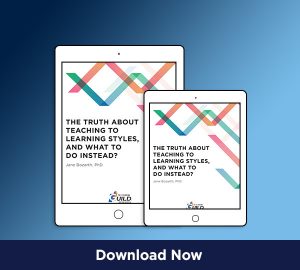David Kelly’s Curated L&D Content for the Week of 9/24/18
 This week’s curated content includes links exploring the following:
This week’s curated content includes links exploring the following:
- How Walmart is using VR for training in its stores
- How technology will help us combat the deluge of fake and misleading content found online.
- Tips on how to build great stories
- Looking to empathy t understand design thinking
- Tools to start playing with augmented reality
- The story behind the emergence of MBTI
Walmart is putting 17,000 Oculus Go headsets in its stores to help train employees in VR by Lucas Matney
In what may be the highest profile example of VR being used for training, Walmart will be expanding its VR training program to all stores. In addition to hearing how the company is using VR for training, it’s also interesting to see how their use of VR technology is also evolving (from tethered to stay-alone VR).
Is content validation the next growth industry? by Ryan Holmes
Learning is becoming a self-service activity. We’re also seeing curation increasingly used by learning professionals as a means of enhancing learning and performance strategies. But what happens when the world of online content is increasingly muddied by content that is intentionally misleading? This post explores that world and the technologies emerging to verify what we are consuming online.
Visualize the Story First When Designing Instructional Comics by Kevin Thorn
Storytelling is an integral part of learning. Many of us know this, but to use stories effectively, you need to go deeper than simply “make it a story”. Our understanding of stories gets a little fuzzier when it comes to building an effective story. While this post focuses on instructional comics, to storytelling advice it shares is easily transferable to other mediums.
Designing with Empathy for Your Users by RocketAir
Design thinking is one of the hottest buzzwords in our industry. I sometimes get frustrated by conversations and posts about design thinking, as it’s too often described as if it were some mystical concept unlike anything we’ve ever seen before. This post takes a different approach, focusing design thinking on something most of us can relate to: empathy.
5 top AR tools to try today by Mark Shufflebottom
Augmented Reality technology continues to advance and mature. As it does, the possibilities to use AR for education, training, and performance support become greater. I’ve always felt that the best way to start to understand a new technology is to dive into it and start playing. If you’re curious about the emerging world of augmented reality, this post highlights a few technologies that enable you to explore the space.
How The Myers-Briggs Personality Test Began In A Mother’s Living Room Lab by Melissa Block
The myths around teaching to learning styles have existed for decades. This post doesn’t explore the research around why these beliefs are misguided; it instead explores part of their origins. Understanding how tests like MBTI began can help us understand why these myths are so powerful, and what we can do to combat them to improve our practices.
FREE Access to the Guild’s Learning Styles Research Report
 The practice of catering instruction to an individual’s preferred learning style is common in education and training despite there being ample research available that shows there is no benefit to the practice. In fact, research actually shows that using learning styles can harm your learners, essentially wasting time and energy that could be used to improve learning outcomes.
The practice of catering instruction to an individual’s preferred learning style is common in education and training despite there being ample research available that shows there is no benefit to the practice. In fact, research actually shows that using learning styles can harm your learners, essentially wasting time and energy that could be used to improve learning outcomes.
In the eLearning Guild,s recent research report, The Truth About Teaching to Learning Styles, and What to Do Instead, Jane Bozarth explores the world of learning styles and their effect on learning outcomes. More importantly, she provides alternatives that can address common misconceptions in our practices as educators and trainers.
We consider this one of the most important research reports we have ever published, and have decided to make the report available FREE for everyone. Please download it and read it. Refer it to your friends who work in this field.
The only way we can overcome these myths is through awareness, and it’s our hope that this report will work towards that goal.

Leave a Reply